September 2023, publishing ref: PRN00282
Indicators for the NHS employed pharmacy workforce 2022 to inform future pharmacy professional leadership
The publication of a Pharmacy Workforce Race Equality Standard (PWRES) report is a significant step in creating an evidence base to reveal racism, discrimination and inequality in career progression in the NHS pharmacy workforce and is an important deliverable from the Inclusive Pharmacy Practice (IPP) initiative.
The PWRES provides baseline evidence to quantify representation, experience and discrimination in NHS-employed pharmacy teams at March 2022, using Electronic Staff Record (ESR) data and the NHS Staff Survey results, and hence identifies the opportunities for employers and pharmacy professional leaders to improve and take action to address inequalities.
Of the 51,440 pharmacists and 20,768 pharmacy technicians in England in March 2022, 11,396 pharmacists and 8,443 pharmacy technicians were employed by NHS trusts. 43.3% (4,934) of pharmacists and 19.2% (1,625) of pharmacy technicians in NHS trusts in England were from a Black, Asian and minority ethnic background in March 2022 compared to 18% of the general population of England[1].
In terms of career progression, this report shows that all pharmacists of Black, Asian and minority ethnic origin are underrepresented at higher agenda for change (AfC) bandings and that female pharmacists of Black, Asian and minority ethnic origin are particularly affected. It also shows that Black, Asian and minority ethnic pharmacy technicians are overrepresented in lower AfC bandings.
In terms of staff experience, it shows that pharmacy team members of Black, Asian and minority ethnic origin experience more harassment, bullying and abuse, poorer career progression and greater experience of discrimination than White pharmacy team members. It also highlights that pharmacy team members of Black ethnic origin are least likely to feel their trust provides equal opportunities for career progression or promotion, and that Black, Asian and minority ethnic female pharmacy team members report the most personal discrimination at work.
Experiences of racism, discrimination and lack of career progression amongst Black, Asian and minority ethnic pharmacy professionals and wider team members in NHS trusts are unacceptable, and more must be done to make sure pharmacists, pharmacy technicians and wider pharmacy team members in trusts have equity of experience and opportunity. Improving workforce experiences and leadership opportunities is essential – the impact of racial discrimination takes a toll on the people affected and also negatively impacts on patient care and healthcare outcomes.
We have published a Chief Pharmaceutical Officer’s IPP Delivery Plan alongside the PWRES that outlines the NHS England Chief Pharmaceutical Officer’s (CPhO) Team’s internal response to the PWRES data. This report also calls on pharmacy professional leaders in NHS trusts and integrated care boards (ICBs) to use the profession specific data coupled with the latest Workforce Race Equality Standard report and NHS England’s Equality, Diversity and Inclusion Improvement Plan to provide impetus for their work to address workforce and health inequalities – as a core responsibility of their leadership role – and sets out some specific actions.
The intention is that the PWRES indicators will be published bi-annually to enable pharmacy leaders and teams to monitor progress and create trend data.
For pharmacy professionals and team members working in community pharmacy and general practices, we would encourage employers to link with national organisations as part of the IPP partnership, and to review their data and take similar action.
The ultimate aim is for all employers across all settings to bring about the positive change we wish to see in people’s experiences of career progression, discrimination and racism, to ensure all colleagues are treated with the respect and fairness that they deserve, and that we retain the skills and maximise the potential of our diverse pharmacy workforce.
David Webb
Chief Pharmaceutical Officer for England
Chair of the IPP Advisory Board
Introduction
- As set out in the NHS People Plan, in order to provide the best possible care for patients, the NHS needs more people, working differently, in a compassionate and inclusive culture.
- Delivering this means tackling racial discrimination to bridge the gaps in experience, opportunity and differential attainment in its diverse workforce. Central to addressing these inequities is the presentation of detailed data to organisational leaders to allow them to identify targets for action.
- The NHS is the fifth largest employer in the world, with March 2022 data showing 24% of its workforce in NHS trusts are of Black, Asian and minority ethnic origin. Yet there is substantial evidence showing that Black, Asian and minority ethnic staff are treated less favourably than their White colleagues and have poorer experience at work and fewer career progression opportunities. Evidence has shown that this disparity has a direct impact on patient experience and that there is a clear link between staff experience and patient satisfaction. (Please see Annex B for relevant evidence.)
- Pharmacists and pharmacy technicians are one of the largest professional groups in the NHS with over 72,000 practitioners working across all parts of the service in hospitals, mental health and community services, general practices and community pharmacies. Pharmacists constitute an ethnically diverse healthcare profession with the General Pharmaceutical Council’s (GPhC) registrant diversity data from May 2022 showing that 56.4% of pharmacists were from a Black, Asian or minority ethnic background, while the GPhC data for pharmacy technicians shows that 17.3% were from a Black, Asian or minority ethnic background.[2]
- The IPP initiative, a partnership of 16 national pharmacy organisations led by the CPhO Team at NHS England, the Association of Pharmacy Technicians UK and the Royal Pharmaceutical Society, set out its aim in September 2020: to work collaboratively to develop and embed inclusive pharmacy professional practice into everyday care for patients and members of the public, to support the prevention of ill-health and address health inequalities within our diverse communities.
- To help improve equality, diversity and inclusion within pharmacy teams, we have developed a PWRES to make this national data available for the first time. This will enable regional and local teams to compare it with their own data to facilitate improvement. It comprises six indicators, based on pharmacy team members (pharmacists, pharmacy technicians and wider, unregistered team members) employed by the NHS in secondary care trusts, where we have access to the employment data. For pharmacy team members employed in community pharmacy, the Community Pharmacy Workforce Survey became a mandatory requirement in 2022. The survey provides an opportunity for contractors to provide limited information on demographics. For pharmacy team members employed in general practices and primary care networks, the National Workforce Reporting Service primary care network data includes age and ethnicity. A general practice team staff survey will be launched by NHS England later this year to align with the NHS Staff Survey and will capture key WRES and Workforce Disability Equality Standard indicators – marking a critical step towards the implementation of workforce equality standards.
- The NHS England NHS England Workforce Race and Equality Standard (WRES) was launched in 2015 to document the different experience of White and Black, Asian and minority ethnic staff employed by the NHS, and to provide guidance on how to achieve better race equality in the workforce, and the first WRES report was published in 2016. The aim of the WRES is to ensure employees from Black, Asian and minority ethnic backgrounds have equal access to career opportunities and receive fair treatment in the workplace.
- The purpose of WRES action plans and implementation plans are to demonstrate the General Equality Duty since WRES indicators are to evidence the Specific Duties (see Equality Act 2010). All public sector bodies have duties under the Equality Act 2010 to deliver on their Public Sector Equality Duty which includes advancing equality, fostering good relations and eliminating discrimination.
- The first Medical WRES report, covering doctors and dental staff employed by the NHS in secondary care and clinical commissioning groups now ICBs, was published in July 2021.
- The WRES data already collected for NHS trusts shows that Black, Asian and ethnic minority representation has increased on boards and at very senior management level, and also that, at a national level, the percentage of Black, Asian and minority ethnic staff going through formal disciplinary proceedings is no longer disproportionately higher than the percentage of White staff going through formal disciplinary proceedings.
- The development of the PWRES indicators was informed by the WRES and comprises a limited set of indicators that focus on greater transparency about the composition of senior leadership in the NHS employed pharmacy workforce as a whole, as well as the incidence of harassment, bullying and discrimination. The work was developed under the IPP initiative in the Chief Pharmaceutical Officer’s Team and indicators were selected to inform developments in future pharmacy professional leadership. The indicators draw on the research evidence and data collection was informed by publications from a wide range of organisations, including the General Pharmaceutical Council, the Association of Pharmacy Technicians UK, the Royal Pharmaceutical Society, and Health Education England (now the Workforce, Training and Education Directorate in NHS England). All data is available in the public domain.
- Information on trainee pharmacist experiences is reported annually through the National Education and Training Survey which is available on an NHS trust basis or by professional group. This information can be used with the indicators in this report to inform action in relation to the learning environment. The survey, which is being further developed, currently captures trainee experience and includes specific questions especially in relation to bullying and harassment. There is no central register of trainee pharmacy technicians which means there is no data on the diversity of this group.
- In England, pharmacist and pharmacy technician opportunities for professional development, and appointments to substantive and training posts and leadership roles, are influenced not only by the leadership of individual employing NHS trusts, but also by the Workforce, Training and Education Directorate of NHS England, the General Pharmaceutical Council, the Association of Pharmacy Technicians UK and the Royal Pharmaceutical Society and. Further work by these organisations would enable the development of additional indicators capable of illuminating racial inequalities in the pharmacy workforce.
Areas for action for pharmacy professional leadership
NHS trusts and ICBs are already taking action to use data and the recommendations of the review by Sir Gordon Messenger Leadership for a Collaborative and Inclusive Future to address inequalities, guided by the strategy set out in the latest Workforce Race Equality Standard report and in the NHS England’s Equality, Diversity and Inclusion Improvement Plan, both published in 2023.
This report makes a clear statement that pharmacy professional leaders in NHS England, NHS trusts and ICBs should use the profession specific data to provide impetus for their work to address workforce and health inequalities – as a core responsibility of their leadership role – and sets out some specific actions.
Chief Pharmaceutical Officer’s Pharmacy Advisory Group
The senior pharmacy professional leadership team in NHS England:
- Implement the Chief Pharmaceutical Officer’s IPP Delivery Plan to reduce the ethnic disparity in representation in senior pharmacy professional leadership roles in the Pharmacy Advisory Group membership and improve career progression within NHS England, eg AfC band 8a and above, including developing greater awareness and understanding of the intersectionalities.
- IPP Advisory Board and wider partnership to continue work collaboratively to lead and drive improvement of the diversity of senior pharmacy professional leadership in the NHS.
NHS trust and ICB pharmacy professional leaders:
- Drive and contribute to local action plans to increase the diversity in representation in senior pharmacy professional roles and improve career progression within NHS trusts, including developing greater awareness and understanding of the intersectionalities, with particular attention to:
- For pharmacists, monitoring the recruitment, retention and progression rate of Black, Asian and minority ethnic pharmacists from AfC band 8a to band 9, and in particular the career progression of Black, Asian and minority ethnic women.
- For pharmacy technicians, monitoring the recruitment, retention and progression rate of female and Black, Asian and ethnic minority pharmacy technicians from AfC band 5 to band 9, with additional attention to creating and widening opportunities for representation in senior pharmacy professional roles by working collaboratively with employers.
- Supporting implementation of the NHS ED&I Improvement Plan work on recruitment and talent management processes to support fairer and equitable recruitment practices for senior pharmacy professional roles, reflective of the workforce and, where applicable, the local population.
- Ensuring pharmacy team members have access to the support of a trained ED&I champion in their workplace.
- Improve the experience of Black, Asian and minority ethnic pharmacists, pharmacy technicians and wider pharmacy team members to address the impact of racial discrimination on the people affected and on patient care and healthcare outcomes through:
- Proactively tackling discrimination through greater education and cultural understanding. Stakeholders should be engaged by leaders to explore the different mechanisms that can be used to keep staff safe psychologically and ensure that speaking up about discrimination and eliminating it becomes integrated into team culture and working.
- Increasing awareness and supporting the implementation of the Supporting our staff: a toolkit to promote cultures of civility and respect within pharmacy teams. Accessing the resources and support available on the Association of Pharmacy Technicians UK, General Pharmaceutical Council and Royal Pharmaceutical Society
- Prioritising comprehensive and sustained pharmacy workforce education and training at all levels to eliminate the conditions and environment in which harassment, bullying, abuse and discrimination occurs.
- Raising awareness with line managers of the process for reporting abuse from patients, relatives and the public on the National Violence Prevention and Reduction Standard and ensuring teams are aware of the support available.
Methodology
Development of indicators
- The overall objective was to develop a set of WRES indicators for the pharmacy workforce that fulfilled the following criteria:
- Broadly similar to the standard WRES indicators in terms of the dimensions of ethnic inequalities they would cover (developmental opportunities, career progression, treatment by patients and employing organisations, and representation).
- Based on data already collected and published, and which could reliably be assessed bi-annually, thus enabling monitoring of trends over time.
- Indicators 1, 2 and 5 reflect variation in career progression.
- Indicators 3, 4 and 6 represent pharmacy team member perceptions of how they are treated by colleagues, employing organisations, and patients.
Data reporting dates
- The latest available data for each indicator was used. Much of the information represents data from 2015 to 2021 and 2022 for experience and composition, respectively.
Data analyses
- For this initial report, we analysed data only at the national level from the NHS directly employed workforce. The indicators will be modified based on constructive feedback received on this publication.
- All the findings highlighted in this report are statistically significant, unless noted otherwise in the narrative. Degrees of underrepresentation or overrepresentation for demographic groups by pay band have been evaluated using the Chi-squared test for independence, followed by post-hoc analysis of standardised residuals. In the staff survey-based data, differences by demographic group in staff experiencing a given outcome have been evaluated using odds ratios. An alpha level of .05 has been adopted.
Data limitations
- This report only contains data from NHS trusts in England.
- Two of the PWRES indicators (1 to 2) are taken from ESR data. It is important to be cautious in drawing robust conclusions from some of the data, for instance in relation to some of the ethnic groups when broken down by pay band, because numbers are very small at the higher bands. In contrast, the NHS Staff Survey data show different and robust patterns for the different ethnic groups in detail, and numbers are higher as the NHS Staff Survey data are not disaggregated by pay band. Thus, the level of detail given is appropriate to the pattern of findings arising from the statistical analysis and the underlying raw numbers.
- The AfC data may include some inaccuracies due to local coding and data entry. There were small numbers of staff at lower bands than expected in the ESR codes used.
- Four of the PWRES indicators (3 to 6) are taken from the questions in the national NHS Staff Survey which were published in March 2022. The annual NHS Staff Survey collects responses from ‘pharmacy’ staff not individual staff groups. The reliability of the data drawn from these indicators is dependent upon the overall size of samples surveyed, the response rates to the survey questions, and whether the numbers of respondents is large enough to achieve confidence in the data. Due to the heterogeneity of the Black, Asian and minority ethnic experience, the aggregated data trends do not necessarily correlate with the disaggregated data trends.
- The indicators will be reviewed and modified as appropriate, in light of any feedback received.
| PWRES indicator | Data sources |
|---|---|
|
1, 2 |
NHS Digital (taken from the ESR) data on NHS trusts – March 2022 |
|
3, 4, 5, 6 |
NHS Staff Survey – March 2022 |
Summary of the PWRES indicators for NHS trusts in England
Unknowns are not presented
| Indicator type | Original WRES indicator (2015 to 2021) | Pharmacy indicator | Indicator descriptor | Black, Asian and minority ethnic | White |
|---|---|---|---|---|---|
| 2022 Workforce composition | 1. Percentage of staff by ethnicity in pay bands which cover all non-medical staff and very senior managers (VSM) | 1. Percentage of Black, Asian and minority ethnic pharmacists within each Agenda for Change band 1-9 compared to the percentage of Black, Asian and minority ethnic pharmacists within the overall pharmacy workforce in 2022 | Registered pharmacists in NHS trusts in England | 43.3% | 52.5% |
| 2022 Workforce composition | 1. Percentage of staff by ethnicity in pay bands which cover all non-medical staff and very senior managers (VSM) | 2. Percentage of Black, Asian and minority ethnic pharmacy technicians within each Agenda for Change band 1-9 compared to the percentage of Black, Asian and minority ethnic pharmacy technicians within the overall pharmacy technician workforce in 2022 | Registered pharmacy technicians in NHS trusts in England | 19.2% | 77.7% |
| 2021 NHS Annual Staff Survey | 5. Percentage of staff experiencing harassment, bullying or abuse from patients, relatives or the public in last 12 months. | 3. Percentage of pharmacy team members experiencing harassment, bullying or abuse from patients, relatives or the public in the last 12 months | All pharmacy staff in NHS trusts in England | 15.3% | 12.5% |
| 2021 NHS Annual Staff Survey | 6. Percentage of staff experiencing harassment, bullying or abuse from staff in last 12 months. | 4. Percentage of pharmacy team members experiencing harassment, bullying or abuse from NHS staff in the last 12 months | All pharmacy staff in NHS trusts in England | 25.3% | 21.1% |
| 2021 NHS Annual Staff Survey | 7. Percentage believing that their trust provides equal opportunities for career progression or promotion | 5. Percentage of pharmacy team members believing that their trust provides equal opportunities for career progression or promotion | All pharmacy staff in NHS trusts in England | 46.3% | 61.8% |
| 2021 NHS Annual Staff Survey | 8. In the last 12 months have you personally experienced discrimination at work? | 6. Percentage of pharmacy team members who have personally experienced discrimination at work in the last 12 months from a manager, team leader or other colleagues | All pharmacy staff in NHS trusts in England | 14.3% | 6.2% |
Key findings: indicator 1
PWRES Indicator 1
Percentage of Black, Asian and minority ethnic pharmacists within each Agenda for Change band 1-9 compared to the percentage of Black, Asian and minority ethnic pharmacists within the overall pharmacy workforce in 2022.
Pharmacists by ethnicity and pay band (% representation), March 2022
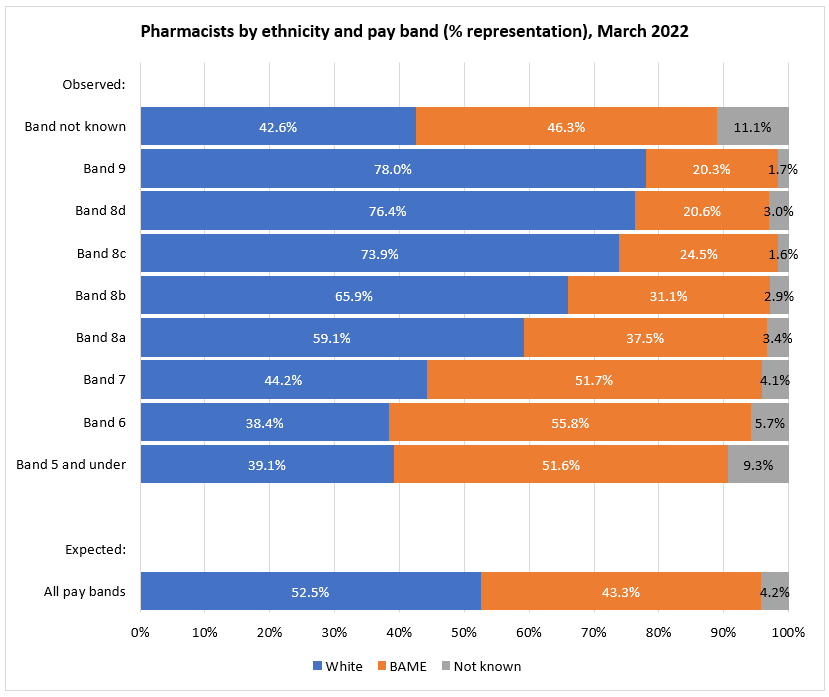
NB: Black, Asian and minority ethnic has been shortened to BAME in the key to the tables.
Headlines
- In March 2022, 43.3% of pharmacists were from Black, Asian and minority ethnic backgrounds compared to 18% of the general population in England[3].
- The percentage of Black, Asian and minority ethnic pharmacists in NHS trusts in England (43.3%) is lower than the overall percentage of pharmacists from a Black, Asian and minority ethnic background in England (56.4%), but higher than the percentage of Black, Asian and minority staff in NHS trusts as a whole (24%).
- In Agenda for Change (AfC) band 8a and above pharmacist roles there is an increasing underrepresentation of Black, Asian and minority ethnic pharmacists (from 37.5% at band 8a to 20.3% at band 9) compared to their level of representation in the overall pharmacist workforce (43.3%).
Pharmacists by ethnicity, gender and pay band (% representation), March 2022
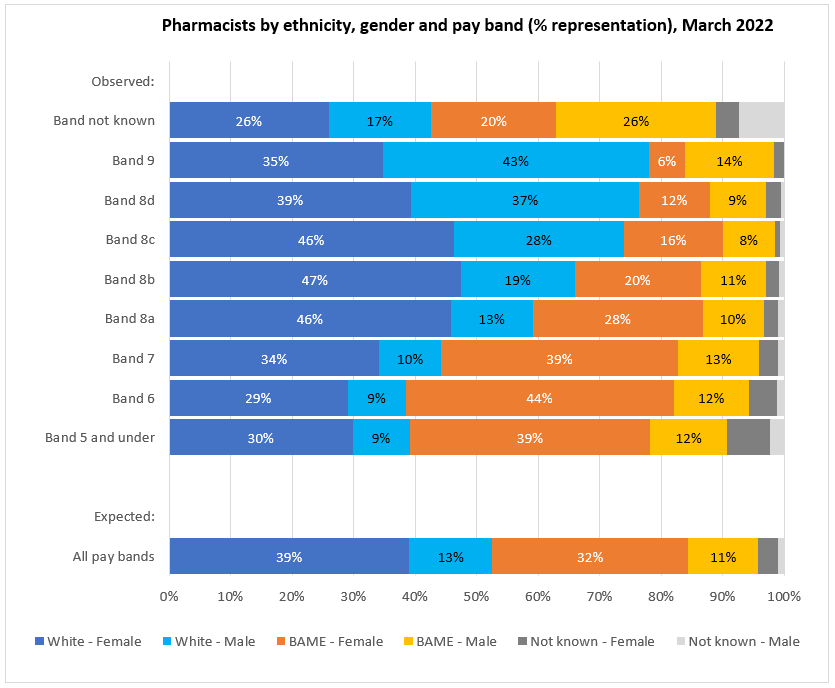
Headlines
- Underrepresentation at higher AfC bandings amongst pharmacists affects Black, Asian and minority ethnic women in particular; Black, Asian and minority ethnic women make up 31.9% of pharmacists overall but just 24.2% of those at band 8a above; with a steep decline in representation from band 8a (27.6%) to band 9 (5.9%).
Key findings: indicator 2
PWRES indicator 2
Percentage of Black, Asian and minority ethnic pharmacy technicians within each Agenda for Change band 1-9 compared to the percentage of Black, Asian and minority ethnic pharmacy technicians within the overall pharmacy technician workforce in 2022.
Pharmacy technicians by ethnicity and pay band (% representation), March 2022
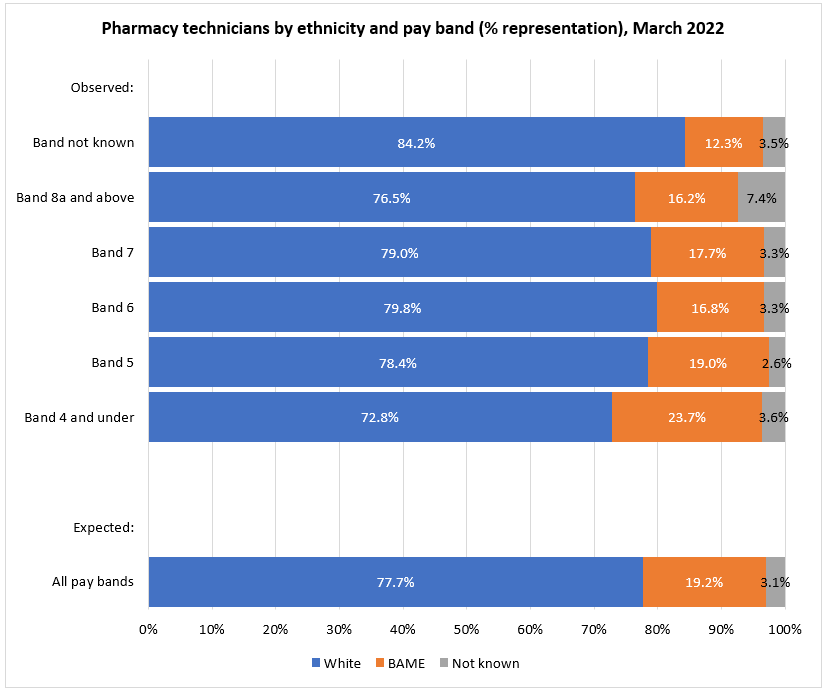
Headlines
- In March 2022, 19.2% of pharmacy technicians were from Black, Asian and minority ethnic backgrounds compared to 18% of the general population in England.
- The percentage of Black, Asian and minority ethnic pharmacy technicians in NHS trusts in England (19.2%) is above the overall percentage of pharmacy technicians from a Black, Asian and minority ethnic background in England which is 17.3%, but lower than the percentage of Black, Asian and minority staff in NHS trusts as a whole (24%).
- Compared to the overall percentage of Black, Asian and minority ethnic pharmacy technicians in NHS trusts (19.2%), Black, Asian and minority ethnic pharmacy technicians were overrepresented in AfC bands 4 and under (23.7%)[4].
Pharmacy technicians by ethnicity, gender and pay band (% representation), March 2022
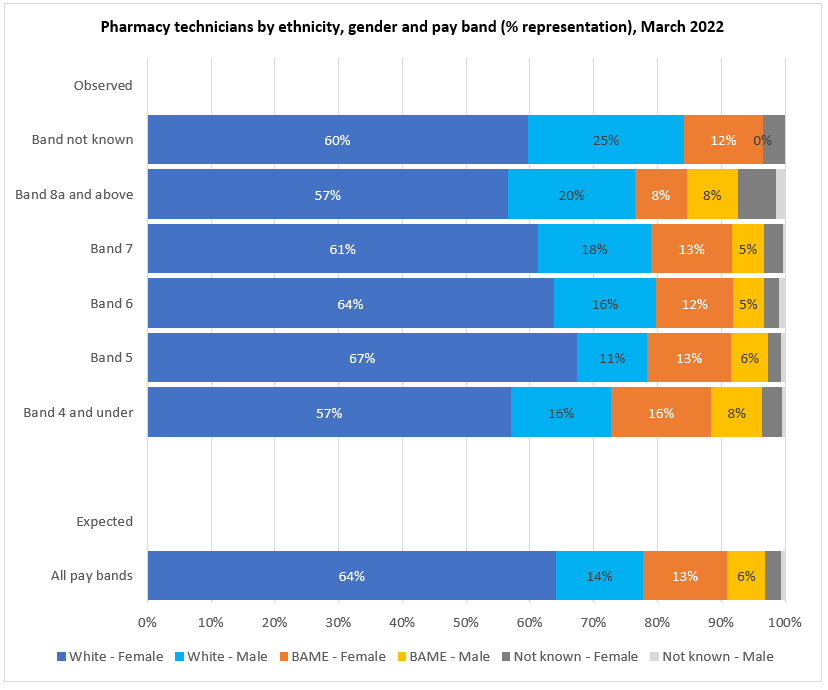
Headlines
- There are just 136 pharmacy technicians at band 8a and above. Due to the small numbers, we cannot make robust inferences about representation by ethnicity or gender at this level.
Key findings: indicator 3
PWRES indicator 3
Percentage of pharmacy team members experiencing harassment, bullying or abuse from patients, relatives or the public in the last 12 months.
Percentage of pharmacy team members experiencing harassment, bullying or abuse from patients, relatives or the public in the last 12 months, by ethnicity
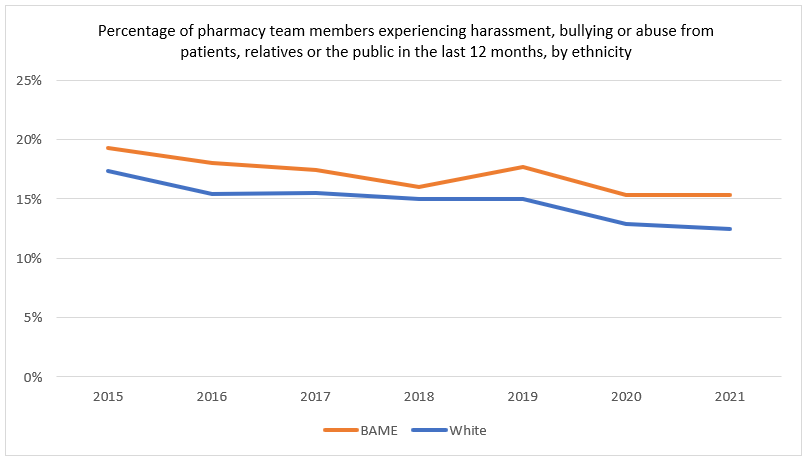
Headlines
- A higher percentage of Black, Asian and minority ethnic pharmacy team members (15.3%) compared with White pharmacy team members (12.5%) reported harassment, bullying or abuse by patients, relatives or the public in the last 12 months, and this trend has been evident since at least 2015.
- There was a reduction in harassment, bullying and abuse from patients, relatives or the public in 2020, which could be attributed to reduced patient facing interaction during the peaks of the COVID-19 pandemic.
Percentage of pharmacy team members experiencing harassment, bullying or abuse from patients, relatives or the public in the last 12 months, by ethnicity in detail
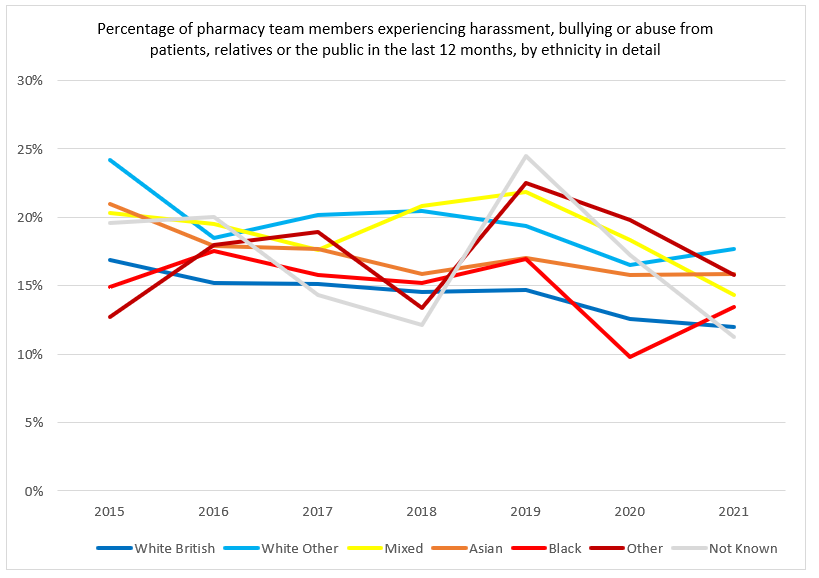
Headlines
- There has been a general downward trend since 2015 in harassment, bullying and abuse from patients, relatives and the public in the last 12 months except towards those from Other ethnic backgrounds, and there is significant variation in experiences across all ethnic groups from 2015 to 2021.
- Pharmacy team members who are White Other (17.7%), Asian (15.9%) and Other (15.8%) reported experiencing the highest levels of harassment, bullying and abuse from patients, relatives or the public in the last 12 months in 2021. (This finding is statistically significant for White Other and Asian staff only, but has been highlighted for Other staff as well, because it affects this group to a similar degree, but narrowly misses statistical significance due to the smaller number of staff in the Other ethnicity category.)
Percentage of pharmacy team members experiencing harassment, bullying or abuse from patients, relatives or the public in the last 12 months, by ethnicity and gender
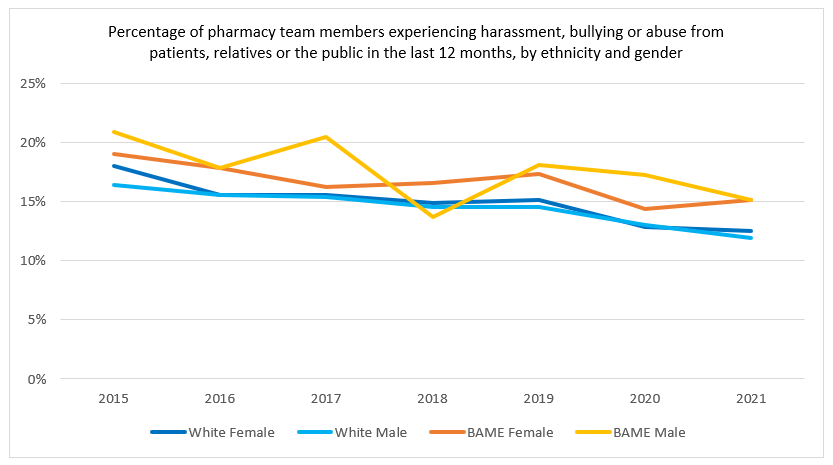
Headlines
- Black, Asian and minority ethnic female (15.2%) and Black, Asian and minority ethnic male (15.2%) pharmacy team members reported experiencing higher rates of abuse, bullying and harassment from patients, relatives or the public in the last 12 months than their White female (12.5%) and White male (11.9%) colleagues in 2021, respectively.
Key findings: indicator 4
PWRES indicator 4
Percentage of pharmacy team members experiencing harassment, bullying or abuse from NHS staff in the last 12 months.
Percentage of pharmacy team members experiencing harassment, bullying or abuse from NHS staff in the last 12 months, by ethnicity
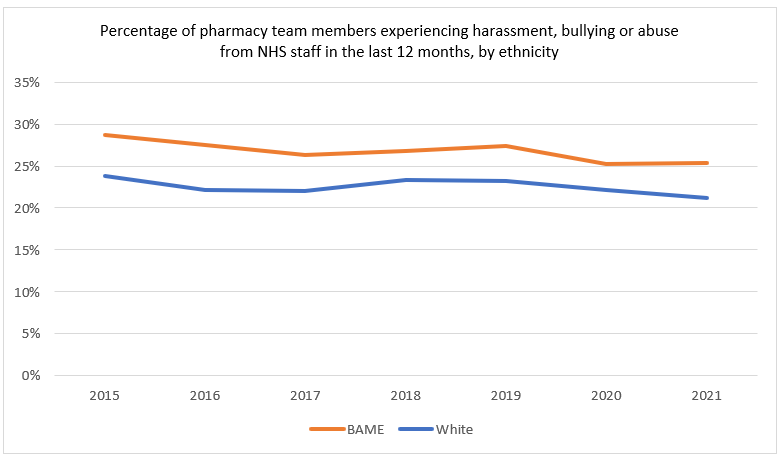
Headlines
- A higher percentage of Black, Asian and minority ethnic pharmacy team members (25.3%) than White pharmacy team members (21.1%) reported harassment, bullying or abuse from NHS staff in the last 12 months, and this trend has been evident since at least 2015.
Percentage of pharmacy team members experiencing harassment, bullying or abuse from NHS staff in the last 12 months, by ethnicity in detail
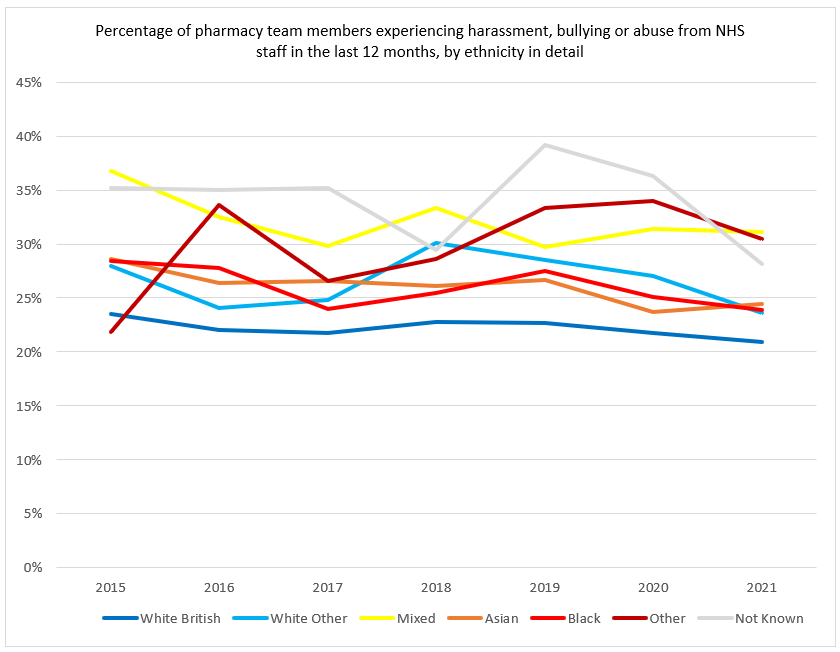
Headlines
- There has been a general downward trend since 2015 in harassment, bullying and abuse from NHS staff in the last 12 months except towards those from Other ethnic backgrounds, but there is significant variation in experiences across all ethnic groups from 2015 to 2021.
- Pharmacy team members who are Mixed ethnicity (31.1%), Other ethnicity (30.4%) and Asian (24.5%) reported experiencing the highest levels of harassment, bullying and abuse from NHS staff in the last 12 months in 2021.
Percentage of pharmacy team members experiencing harassment, bullying or abuse from NHS staff in the last 12 months, by ethnicity and gender
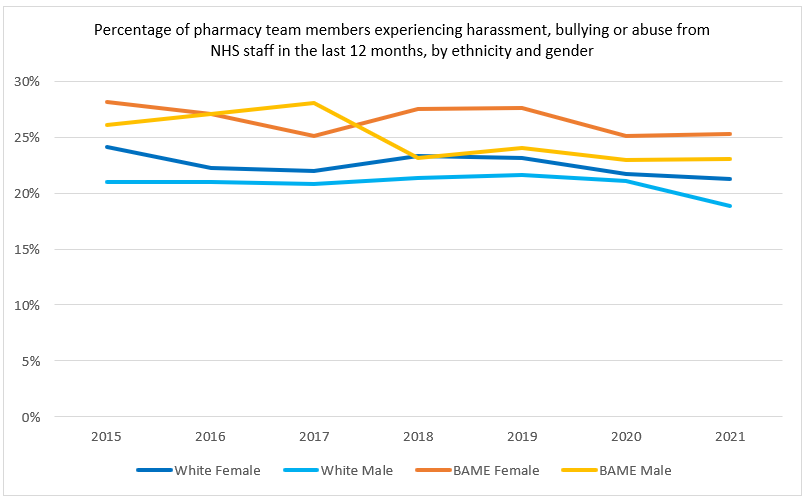
Headlines
- Black, Asian and minority ethnic female (25.3%) and Black, Asian and minority ethnic male (23%) pharmacy team members reported experiencing higher rates of harassment, bullying and abuse from NHS staff in the last 12 months than their White female (21.3%) and White male (18.8%) colleagues in 2021, respectively.
Key findings: indicator 5
PWRES indicator 5
Percentage of pharmacy team members believing that their trust provides equal opportunities for career progression or promotion.
Percentage of pharmacy team members believing that their trust provides equal opportunities for career progression or promotion, by ethnicity
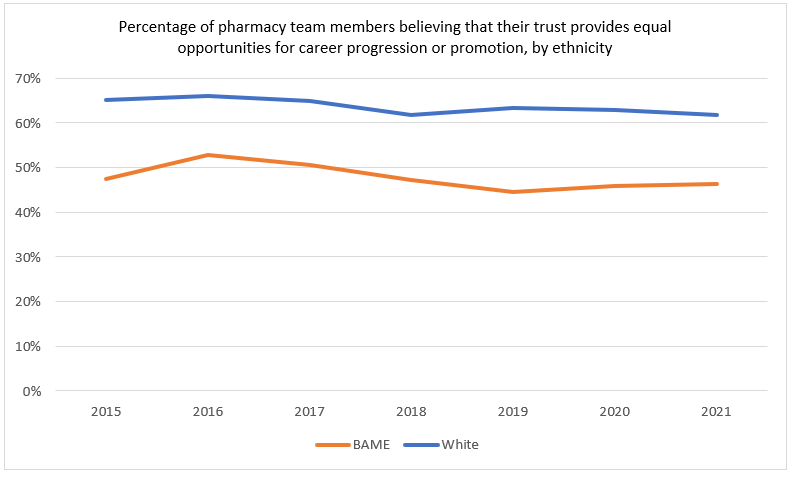
Headlines
- Just under half of Black, Asian and minority ethnic pharmacy team members (46.3%) compared with just under two-thirds of White pharmacy team members (61.8%) felt that their trust provides equal opportunities for career progression or promotion; and this trend has been evident since 2015.
Percentage of pharmacy team members believing that their trust provides equal opportunities for career progression or promotion, by ethnicity in detail
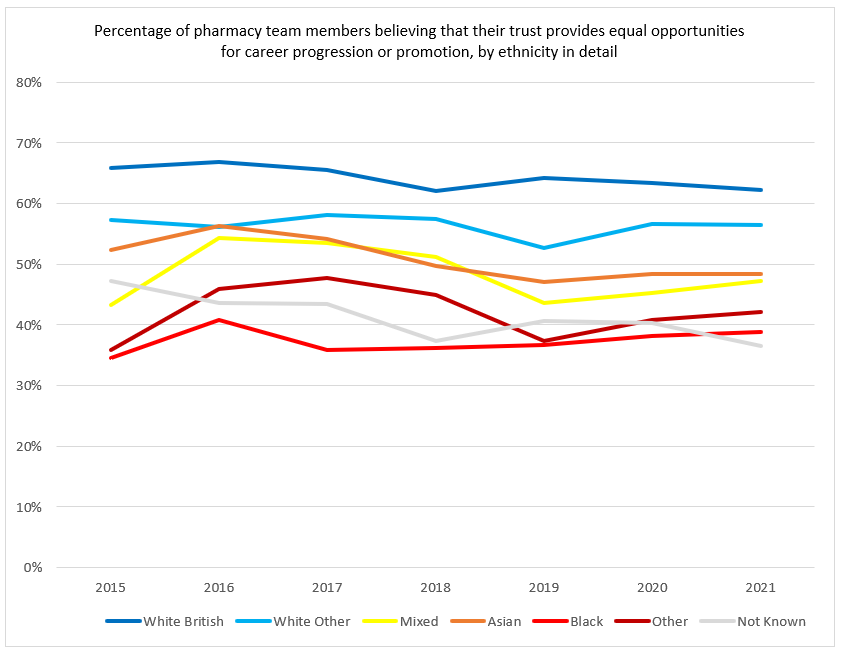
Headlines
- In particular it was identified that Black pharmacy team members (38.8%) were least likely to feel their trust provides equal opportunities for career progression or promotion and this trend has been evident since at least 2015.
Percentage of pharmacy team members believing that their trust provides equal opportunities for career progression or promotion, by ethnicity and gender
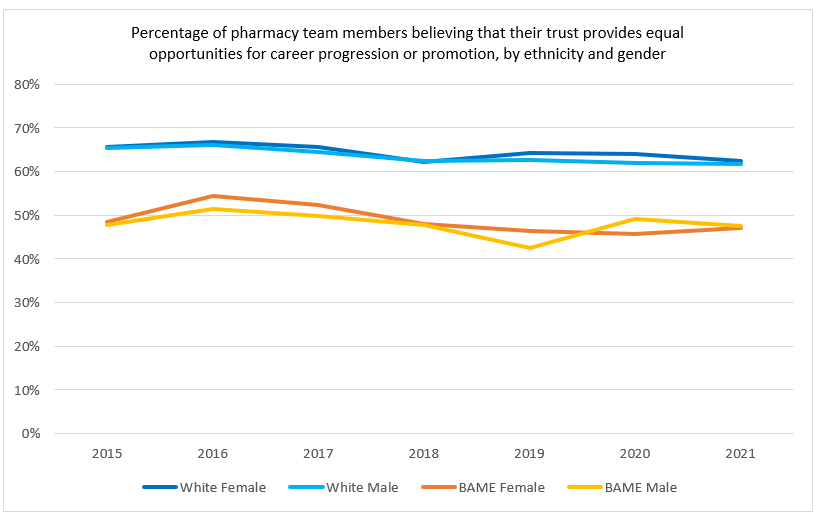
Headlines
- A lower percentage of Black, Asian and minority ethnic female (47.1%) and Black, Asian and minority ethnic male (47.5%) pharmacy team members compared with White female (62.5%) and White male (61.7%) pharmacy team members felt that their trust provides equal opportunities for career progression or promotion in 2021, respectively.
Key findings: indicator 6
PWRES indicator 6
Percentage of pharmacy team members who have personally experienced discrimination at work in the last 12 months from a manager, team leader or other colleagues.
Percentage of pharmacy team members who have personally experienced discrimination at work in the last 12 months from a manager, team leader or other colleagues, by ethnicity
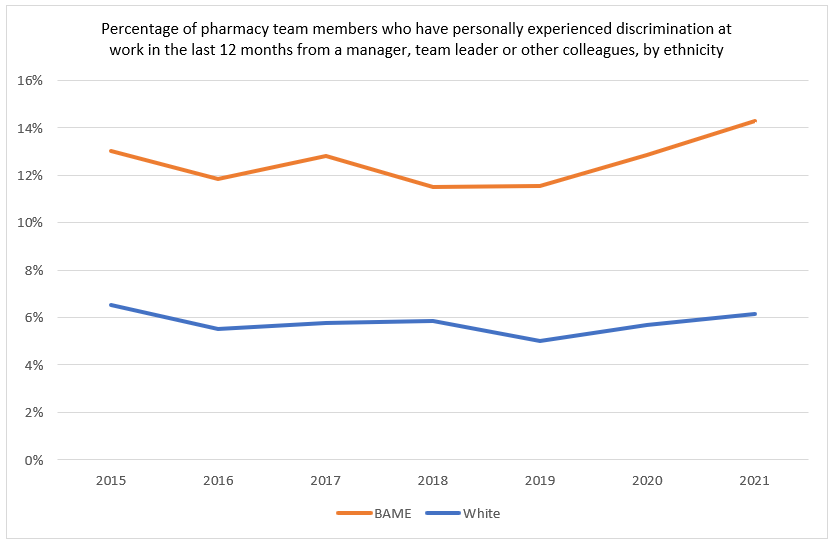
Headlines
- There has been a general upward trend since 2018 in pharmacy team members who have reported personally experiencing discrimination at work in the last 12 months from a manager, team leader or other colleagues.
- Black, Asian and minority ethnic pharmacy team members (14.3%) are more than twice as likely than White pharmacy team members (6.2%) to report having personally experienced discrimination at work in the last 12 months from a manager, team leader or other colleagues and this trend has been evident since at least 2015.
Percentage of pharmacy team members who have personally experienced discrimination at work in the last 12 months from a manager, team leader or other colleagues, by ethnicity in detail
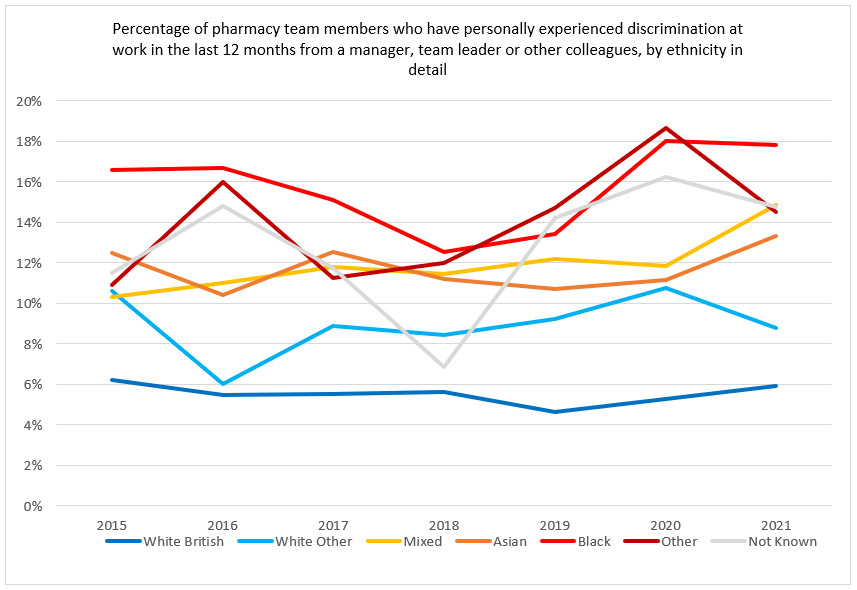
Headlines
- Black pharmacy team members reported personally experiencing most discrimination at work in the last 12 months from a manager, team leader or other colleagues (17.8%). However, levels are higher for all Black, Asian and minority ethnic pharmacy team members compared to those from White Other (8.8%) and White British (5.9%) backgrounds in 2021.
- In 2021, Black pharmacy team members were three times more likely to report personal experience of discrimination at work in the last 12 months from a manager, team leader or other colleagues compared with White British team members.
Percentage of pharmacy team members who have personally experienced discrimination at work in the last 12 months from a manager, team leader or other colleagues, by ethnicity and gender
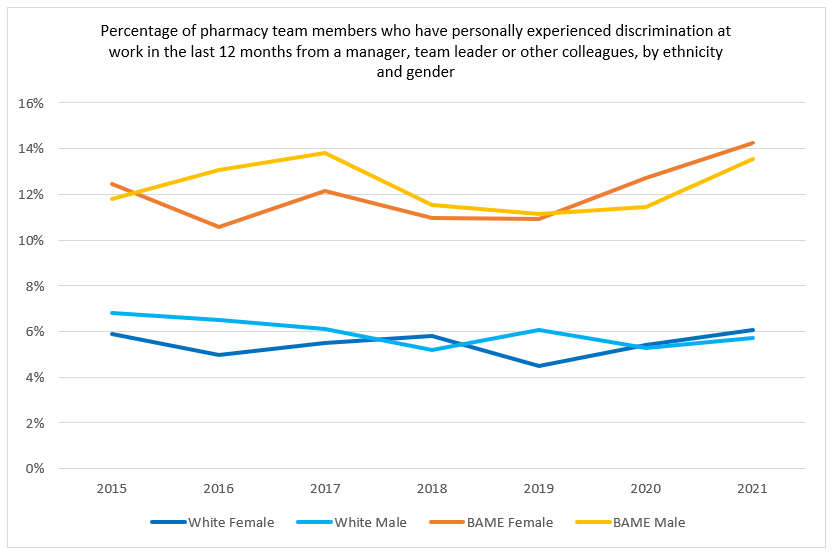
Headlines
- Black, Asian and minority ethnic female (14.2%) and Black, Asian and minority ethnic male (13.6%) pharmacy team members were most likely to report personally experiencing discrimination at work in the last 12 months from a manager, team leader or other colleagues compared to their White female (6.1%) and White male (5.7%) colleagues in 2021, respectively.
- Since 2019, Black, Asian and minority ethnic female pharmacy team members have reported personally experiencing the most discrimination at work in the last 12 months from a manager, team leader or other colleagues.
Annex A: NHS England wellbeing resources
- NHS England » Support available for our NHS people
- NHS England » Support for our diverse colleagues
- NHS England » Wellbeing apps,
- NHS England » Financial wellbeing
- NHS England » Handling difficult situations with compassion – training programme
- NHS England » Looking after your team’s health and wellbeing guide.
Annex B: Evidence and reports
NHS England (2023) Equality, Diversity and Inclusion Improvement Plan
NHS England (2023) Workforce Race Equality Standard
NHS Staff Survey (2023) Working together to improve NHS staff experiences | NHS Staff Survey (nhsstaffsurveys.com)
British Medical Association (2022) Why are we still here?
Messenger Review (2022) Leadership for a Collaborative and Inclusive Future
NHS Confederation (2022) Shattered Hopes
NHS Providers (2022) Race Equality
NHS England (2021) Medical Workforce Race Equality Standard
NHS East of England (2021) No More Tick Boxes
Royal College Nursing (2021) Workforce Diversity and Employment Experiences
Annex C: PWRES Working Group
|
Name |
Organisation |
Role |
|
Natasha Callender |
NHS England |
Future Practice Advisor |
|
Richard Cattell |
NHS England |
Deputy Chief Pharmaceutical Officer |
|
Iain Darker |
NHS England |
WRES Implementation Manager |
|
Professor Anton Emmanuel |
NHS England |
Interim Senior Clinical Lead for the WRES programme |
|
Riyaz Patel |
NHS England |
WRES Implementation Lead |
|
Karl Taylor |
NHS England |
Senior Analyst, Hospital Pharmacy and Medicines Optimisation Team |
Annex D: Acknowledgements
We would like to record our thanks to these individuals who have supported and contributed to the preparation of this publication:
Professor Diane Ashiru-Oredope, Melanie Boast, Kevin Cahill, Roz Cheeseman, Amandeep Doll, Liz Fidler, Olivia King, Sue Ladds, Farzana Mohammed, Professor Mahendra Patel OBE, Aiysha Raoof, Kieran Reynolds, Claire Steele.
References
[1] Ethnicity facts and figures service from Gov.uk.
[2] These figures include the category ‘Any Other Ethnic Group’.
[3] The AfC data may include some inaccuracies due to local coding and data entry. There were small numbers of staff at lower bands than expected in the ESR codes used.
[4] The AfC data may include some inaccuracies due to local coding and data entry. There were small numbers of staff at lower bands than expected in the ESR codes used.

